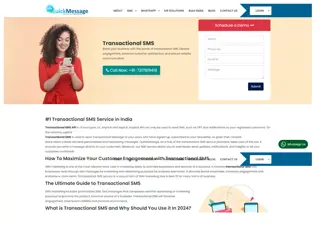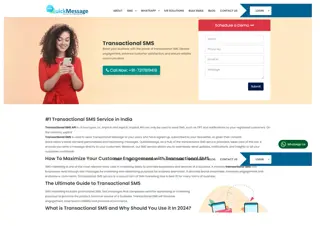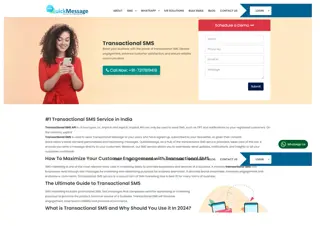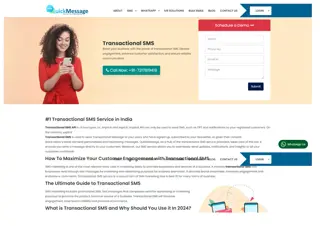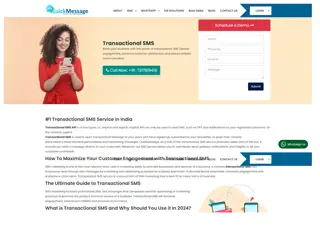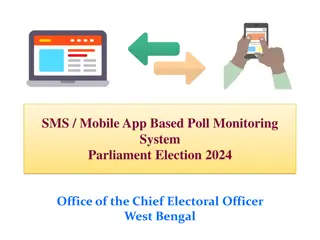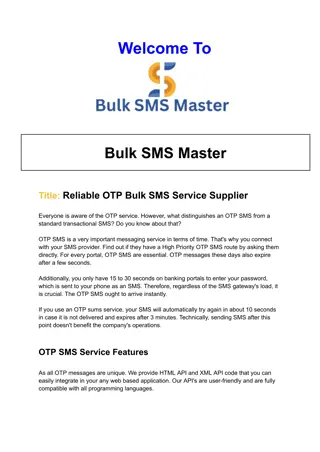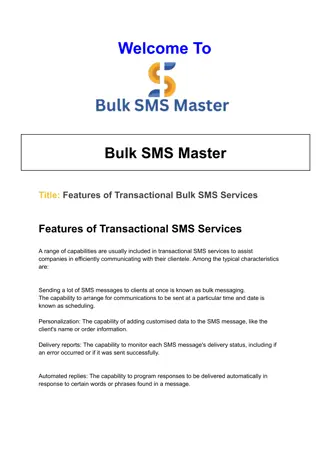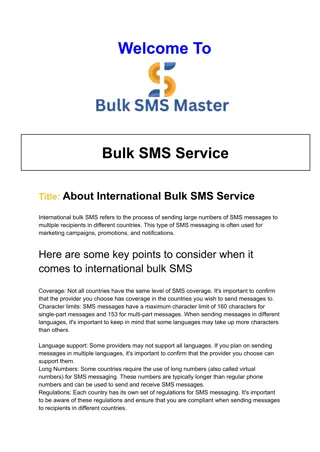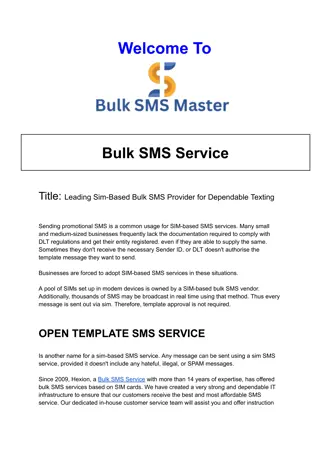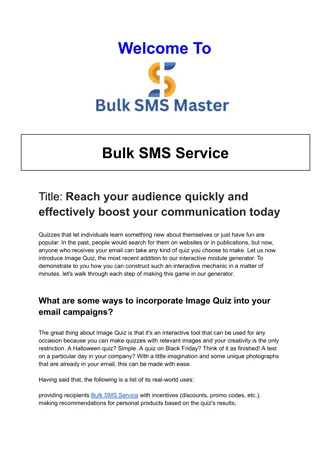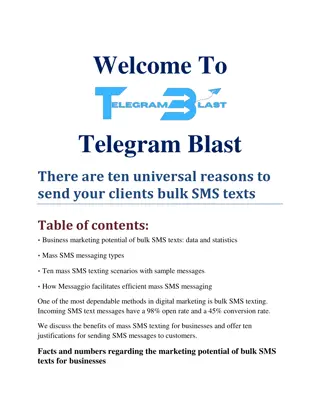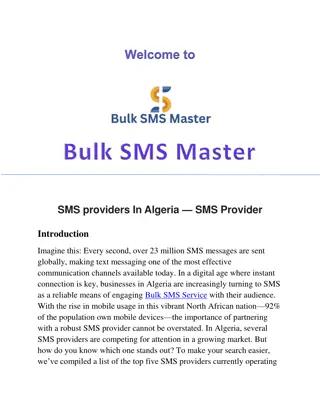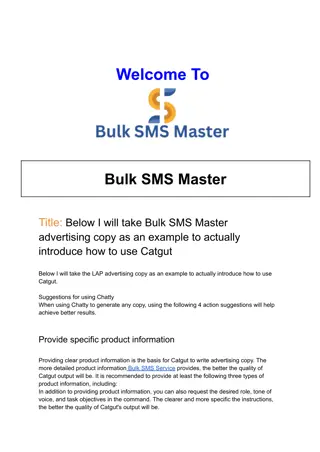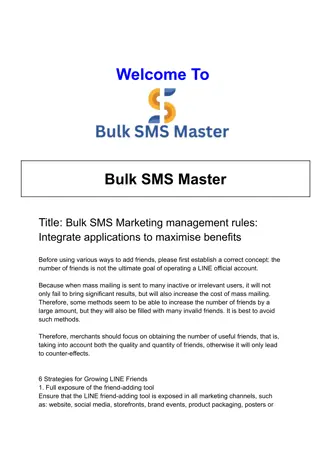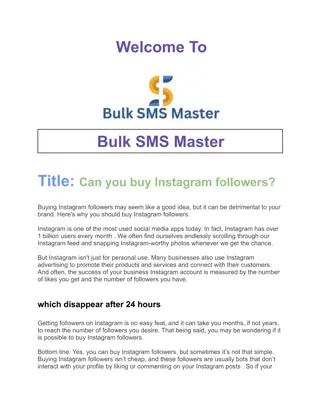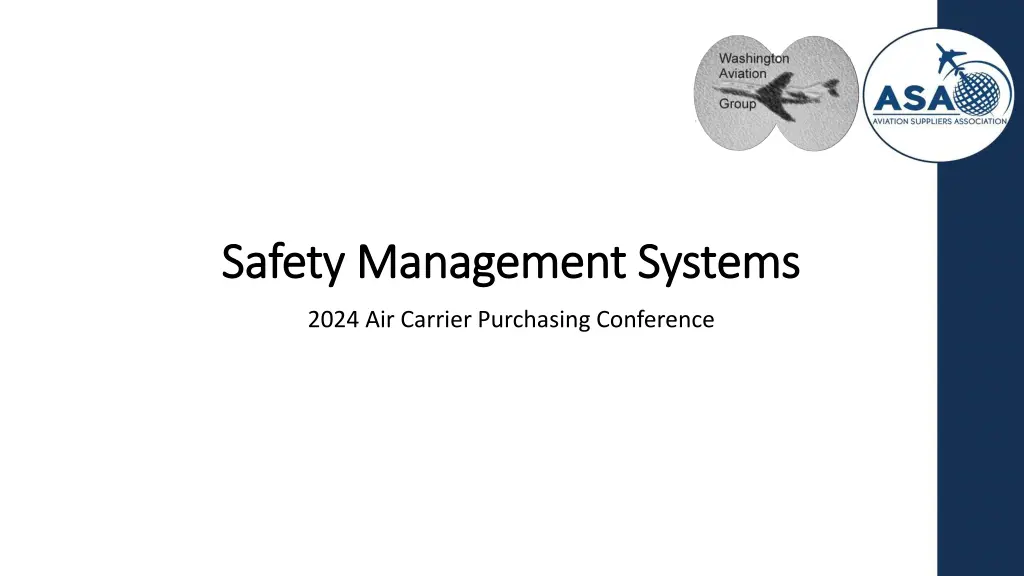
Understanding SMS Requirements for Aviation Safety Management Systems
"Learn about SMS requirements for aviation safety management systems, including regulations, resources, and implementation tips. Discover when SMS rules apply to US repair stations and the importance of Safety Risk Management. Find essential information to establish effective Safety Management Systems in the aviation industry."
Download Presentation

Please find below an Image/Link to download the presentation.
The content on the website is provided AS IS for your information and personal use only. It may not be sold, licensed, or shared on other websites without obtaining consent from the author. If you encounter any issues during the download, it is possible that the publisher has removed the file from their server.
You are allowed to download the files provided on this website for personal or commercial use, subject to the condition that they are used lawfully. All files are the property of their respective owners.
The content on the website is provided AS IS for your information and personal use only. It may not be sold, licensed, or shared on other websites without obtaining consent from the author.
E N D
Presentation Transcript
Safety Management Systems Safety Management Systems 2024 Air Carrier Purchasing Conference
Who is this Guy? Aviation attorney since 1992 General Counsel to the Aviation Suppliers Association since 1997 Our law firm represents and counsels air carriers, manufacturers, repair stations and distributors Worked with governments on developing SMS and work with aviation businesses to establish SMS systems 2024 ACPC Safety Management Systems 2
Learning Goals Understand the basic structure of SMS Understand how to use Safety Risk Management Learn how Safety Risk Assessment functions Learn some tips on how to make your own Safety Risk Management process valuable to your organization 2024 ACPC Safety Management Systems 3
Where Can I Find U.S. SMS Resources? 14 C.F.R. 5.1 et seq. [the regulations] AC 120-92D [SMS for Aviation Service Providers] 8000.369C [FAA SMS Order] 8000.377 [FAA Flight Standards SMS Order] SM-0001 [industry guide] 2024 ACPC Safety Management Systems 4
SMS as a U.S. Requirement SMS under 14 C.F.R. Part 5 is required for Certain Manufacturers Type Certificate holders that allow someone else to produce Production Certificate holders Certain Operators 121 air carriers 135 operators 91.147 (letter of authorization) operators It is not required for Part 145 repair stations 2024 ACPC Safety Management Systems 5
When Does Part 5 (SMS Rules) Apply to a US Repair Station? FAA and EASA have agreed that SMS will be a special condition under the maintenance annex of the Bilateral Aviation Safety Agreement (expected for MAG 10) US-based repair stations holding EASA 145 privileges will need to establish SMS to meet the European special condition Participation in the FAA voluntary SMS program will be acceptable to EASA Will need to coordinate with the FAA Will need to implement a program that meets Part 5 2024 ACPC Safety Management Systems 6
SMS Is Not SMS will not be a drop-in replacement for your quality assurance system But it might coordinate and rely on your quality assurance system SMS is not the last-best-system you will ever use There is always another system But SMS should stick around for awhile because of the upcoming regulations SMS is not simple it is a complicated structure of interlocking pieces But many of the system elements may already exist in your existing model If the pieces work together properly, then they can use their synergy to make this system even more valuable than the pieces 2024 ACPC Safety Management Systems 7
Weve All Got Quality Systems, Already Why should we care about SMS? It is being required by regulations ICAO mandated it and established the standard for governments to follow FAA and EASA already require SMS for air carriers EASA is imposing SMS requirements on manufacturer and repair stations Regulations have been released We are in the phase-in period FAA is planning to coordinate with EASA SMS requirements 2024 ACPC Safety Management Systems 8
Why Else Should We Care About SMS? It can add safety value It can add management tools to help management understand the organization s safety posture It can add management tools to help management understand the organization s safety response It can offer an improved mechanism for proactive management of risk It can offer an improved mechanism for managing change But to get these benefits, you have to build an effective system 2024 ACPC Safety Management Systems 9
SMS Looks a Bit Like QMS In many ways, SMS is like a traditional Quality Management System (QMS) with some added safety analysis elements, and without some non-safety elements (like customer service) : SMS-Only Elements Like: Proactive Hazard Identification Formal Risk Assessment and Analysis QMS-Only Elements Like: Customer Satisfaction On Time Delivery SMS QMS SMS overlaps with QMS and can rely on elements of QMS 2024 ACPC Safety Management Systems 10
SMS Looks a Bit Like QMS; So Make Use of Your Existing QMS In many ways, SMS is like a traditional Quality Management System (QMS) with some added safety analysis elements, and without some non-safety elements (like customer service) This means that you can use your QMS as a foundation for SMS Reuse QMS processes, like hazard identification and corrective action Rely on QMS processes as mitigations (take credit for your existing systems) SMS QMS SMS overlaps with QMS and can rely on elements of QMS 2024 ACPC Safety Management Systems 11
SMS is Proactive SMS identifies hazards and proactively assesses them to identify their risk level SMS invites scrutiny to identify hazards (without necessarily waiting for an occurrence to reveal the hazard) SMS proactively mitigates the risk of hazards to an acceptable level SMS uses Safety Assurance mechanisms and performance indicators to ensure that the mitigations are being successful 2024 ACPC Safety Management Systems 12
Mitigating Black Swan Events The problem with unpredictable events is that you cannot predict them But you can predict (and mitigate) the types of hazards that could face the business For example, few people predicted that Covid-19 would effectively shut down the world But you could have predicted, and mitigated, a hazard of inability for staff to be able to reach the office (for any reason) 2024 ACPC Safety Management Systems 13
The Four Components of SMS Safety Assurance Safety Policy and Objectives Safety Promotion Safety Risk Management 14 2024 ACPC Safety Management Systems
Four Components 1. Safety policy and objectives 1.1 Management commitment 1.2 Safety accountability and responsibilities 1.3 Appointment of key safety personnel 1.4 Coordination of emergency response planning 1.5 SMS documentation 3. Safety assurance 3.1 Safety performance monitoring and measurement 3.2 The management of change 3.3 Continuous improvement of the SMS 2. Safety risk management 2.1 Hazard identification 2.2 Safety risk assessment 2.3 Safety risk mitigation 4. Safety promotion 4.1 Training and education 4.2 Safety communication 2024 ACPC Safety Management Systems 15
Four Components: Each Has Elements 1. Safety policy and objectives 1.1 Management commitment 1.2 Safety accountability and responsibilities 1.3 Appointment of key safety personnel 1.4 Coordination of emergency response planning 1.5 SMS documentation 3. Safety assurance 3.1 Safety performance monitoring and measurement 3.2 The management of change 3.3 Continuous improvement of the SMS 2. Safety risk management 2.1 Hazard identification 2.2 Safety risk assessment 2.3 Safety risk mitigation 4. Safety promotion 4.1 Training and education 4.2 Safety communication 2024 ACPC Safety Management Systems 16
Safety Policy and Objectives 1. Safety policy and objectives 1.1 Management commitment 1.2 Safety accountability and responsibilities 1.3 Appointment of key safety personnel 1.4 Coordination of emergency response planning 1.5 SMS documentation 3. Safety assurance 3.1 Safety performance monitoring and measurement 3.2 The management of change 3.3 Continuous improvement of the SMS safety Management commitment to And the foundational elements that 2. Safety risk management 2.1 Hazard identification 2.2 Safety risk assessment 2.3 Safety risk mitigation 4. Safety promotion 4.1 Training and education 4.2 Safety communication support that commitment Establishing your Safety Policy and Objectives is very important, and it is the place to start in building a new system, BUT we are going to focus on other elements in this presentation 2024 ACPC Safety Management Systems 17
Safety Risk Management 1. Safety policy and objectives 1.1 Management commitment 1.2 Safety accountability and responsibilities 1.3 Appointment of key safety personnel 1.4 Coordination of emergency response planning 1.5 SMS documentation 3. Safety assurance 3.1 Safety performance monitoring and measurement 3.2 The management of change 3.3 Continuous improvement of the SMS Identifying hazards and responding to them to reach an expected level of safety 2. Safety risk management 2.1 Hazard identification 2.2 Safety risk assessment 2.3 Safety risk mitigation 4. Safety promotion 4.1 Training and education 4.2 Safety communication In this workshop we are going to focus on the value that Safety Risk Management can bring to your organization 2024 ACPC Safety Management Systems 18
Safety Assurance 1. Safety policy and objectives 1.1 Management commitment 1.2 Safety accountability and responsibilities 1.3 Appointment of key safety personnel 1.4 Coordination of emergency response planning 1.5 SMS documentation system 3. Safety assurance 3.1 Safety performance monitoring and measurement 3.2 The management of change 3.3 Continuous improvement of the SMS Auditing to ensure that the system works as expected and to improve the 2. Safety risk management 2.1 Hazard identification 2.2 Safety risk assessment 2.3 Safety risk mitigation 4. Safety promotion 4.1 Training and education 4.2 Safety communication Managing Change Safety assurance can be influenced by the safety risk management program You may be able to rely on your existing quality audit system as a part of safety assurance (don t be afraid to use what you already have!) 2024 ACPC Safety Management Systems 19
Safety Promotion 1. Safety policy and objectives 1.1 Management commitment 1.2 Safety accountability and responsibilities 1.3 Appointment of key safety personnel 1.4 Coordination of emergency response planning 1.5 SMS documentation system 3. Safety assurance 3.1 Safety performance monitoring and measurement 3.2 The management of change 3.3 Continuous improvement of the SMS Using training and communication to reinforce the 2. Safety risk management 2.1 Hazard identification 2.2 Safety risk assessment 2.3 Safety risk mitigation 4. Safety promotion 4.1 Training and education 4.2 Safety communication This is also important to a complete SMS, but is outside the scope of our discussion today 2024 ACPC Safety Management Systems 20
Another Way of Looking at SMS Safety Policy and Objectives Safety Assurance Analysis Safety Risk Management Safety Promotion and Other Communications Safety Risk Management Mitigation Safety Assurance 2024 ACPC Safety Management Systems 21
A Grossly Over-Simplified Model of SMS Management sets and revises safety goals Audit may identify additional hazards or inadequately mitigated hazards Business identifies hazards Communication Business mitigates hazards to achieve safety goals Auditors assess the success of the mitigations 2024 ACPC Safety Management Systems 22
Focusing on Safety Risk Management 2024 ACPC Safety Management Systems 23
Safety Risk Management (In Summary) Identify Hazards (proactively when possible) Perform Safety Risk Assessment on each identified hazard This will yield a risk level for the hazard Compare the risk level to metrics established in the Safety Policy & Objectives Mitigate any hazard whose safety risk is unacceptable 2024 ACPC Safety Management Systems 24
How Do I Start? Assume you already have your SMS processes written down, how do start applying SMS to your business? Starting by identifying hazards can be the easiest way to see early results One place to start is with the hazards you ve already identified Identify the hazards that have already been mitigated by your quality system You can examine how your quality system has mitigated the risk of each hazards This lets you take credit for the quality system you already have Working from your existing quality processes allows you to start with a manageable project This will also feed your change management system 2024 ACPC Safety Management Systems 25
A Simple Safety Risk Assessment For each Hazard, Likelihood is given a number Consequence is given a number The two numbers are multiplied The product is your Risk value Warning: just because we are assigning numbers does not make this a quantitative analysis. Typically, this is a qualitative analysis based on the discretion of the system owner To the extent we use numbers, the numbers are for comparison within your system and cannot be compared to numbers in another system 2024 ACPC Safety Management Systems 26
Road Runners Hazard Log For each Hazard, Likelihood is given a number Consequence is given a number The two numbers are multiplied The product is your risk value Hazard Consequence Likelihood Risk Coyote hits Road Runner with falling safe 5 3 15 Coyote explodes Road Runner with dynamite 5 4 20 Coyote pushes Road Runner off cliff 4 3 12 2024 ACPC Safety Management Systems 27
Likelihood We assign values to different likelihood levels The purpose of this assignment is to rank more likely occurrences higher than less likely occurrences We rank more likely occurrences higher in order to be able to prioritize them (over rare occurrences of equal consequence) for purposes of risk assessment The different levels of likelihood should be tailored to reflect the break points that are relevant to your operations If the likely risk of ALL hazards is remote then you MAY need some way to distinguish them Or you may be satisfied that they are all adequately mitigated Remember, this next page is an example your actual standards must be tailored to your system s needs 2024 ACPC Safety Management Systems 28
Likelihood Examples: US MIL STD-882 5 - Frequent - likely to occur frequently 4 - Probable will occur several times in the life of system 3 - Occasional Likely to occur some time in the life of the system 2 - Remote Unlikely but possible to occur in the life of the system 1 - Improbable So unlikely, it can be assumed that occurrence may not be experienced For example, a hazard that is likely to occur some time in the life of the system is considered occasional and is assigned a likelihood value of 3 2024 ACPC Safety Management Systems 29
Likelihood Examples: FAA Risk Management Handbook (Certification) 4 - Probable - likely to occur in lifetime of each system (> 10-5) 3 - Remote Possible for each item, several items for system (< 10-5) 2 Extremely Remote Unlikely for each item, may occur in system (< 10-7) 1 Extremely Improbable So unlikely, it is not expected in the system (< 10-9) For example, a hazard that is likely to arise less than once in 10,000,000 operations is extremely remote and is assigned a likelihood value of 2 2024 ACPC Safety Management Systems 30
Consequence (Sometimes Called Severity) We assign values to different consequence levels The purpose of this assignment is to rank more dire consequences higher than less dire consequences We rank more dire consequences higher in order to be able to prioritize them for purposes of risk assessment You have to define consequences, and levels of consequences, consistent with your own business needs and expectations This also allows you to mitigate to the desired levels You may evolve these levels as your safety management system develops I have offered proposed consequence levels that serve only as a starting place for your own definitions 2024 ACPC Safety Management Systems 31
Proposed Consequences Negligible safety effect. Failure conditions that would have no effect on safety E.g. following instructions in the wrong order, but ascertaining that the order has no safety effect Assign a value of 1 2024 ACPC Safety Management Systems 32
Proposed Consequences Minor. Failure conditions that would not significantly reduce system safety Minor failure conditions may include a slight reduction in safety margins or functional capabilities Minor failure conditions may include a slight increase in personnel workload (such as a routine work process change) Assign a value of 2 2024 ACPC Safety Management Systems 33
Proposed Consequences Major. Failure conditions that would reduce the safety capability of the business, or of a customer, or the ability of personnel to cope with adverse conditions Significant reduction in safety margins or functional capabilities Significant increase in personnel workload Assign a value of 3 2024 ACPC Safety Management Systems 34
Proposed Consequences Hazardous. Failure conditions that would reduce the capability of the business, safety of a customer, or the ability of personnel to cope with adverse safety conditions, including: A large reduction in your safety margins or functional capabilities (e.g. conditions that can permit improper maintenance) A reduction in your customer s safety margins or functional capabilities (e.g. a quality escape) Physical distress or higher workload such that personnel cannot be relied upon to adequately manage safety Assign a value of 4 2024 ACPC Safety Management Systems 35
Proposed Consequences: Possible Definition for Your System Catastrophic. Failure conditions that are expected to affect the operation of a component, part, or element such that it can no longer function as intended for the customer: A quality escape that prevents proper operation (e.g. because it was installed) Assign a value of 5 Recognize that other systems might assign death or hull loss as the top level I have chosen to create a top level that is broader in scope 2024 ACPC Safety Management Systems 36
Risk Table Consequence No Effect (1) Minor (2) Major (3) Hazardous (4) Catastrophic (5) Frequent (5) 5 10 15 20 25 Likelihood Probable (4) 4 8 12 16 20 Occasional (3) 3 6 9 12 15 Remote (2) 2 4 6 8 10 Improbably (1) 1 2 3 4 5 2024 ACPC Safety Management Systems 37
Risk Table Consequence No Effect (1) Minor (2) Major (3) Hazardous (4) Catastrophic (5) Frequent (5) 5 10 15 20 25 Likelihood Probable (4) 4 8 12 16 20 Occasional (3) 3 6 9 12 15 Remote (2) 2 4 6 8 10 Improbable (1) 1 2 3 4 5 Red (10+) Unacceptable level of risk must be mitigated Yellow (5-9) Analyze to weigh whether mitigation is necessary Green (1-4) Acceptable level of risk 2024 ACPC Safety Management Systems 38
Risk Table Consequence No Effect (1) Minor (2) Major (3) Hazardous (4) Catastrophic (5) Frequent (5) 5 10 15 20 25 Likelihood Probable (4) 4 8 12 16 20 Occasional (3) 3 6 9 12 15 Remote (2) 2 4 6 8 10 Improbable (1) 1 2 3 4 5 Correlate the risk levels to the company s safety policy to identify what is acceptable and what is not acceptable As the system matures, you can choose to mitigate other risk levels 2024 ACPC Safety Management Systems 39
A More Mature Table Consequence No Effect (1) Minor (2) Major (3) Hazardous (4) Catastrophic (5) Frequent (5) 5 10 15 20 25 Likelihood Probable (4) 4 8 12 16 20 Occasional (3) 3 6 9 12 15 Remote (2) 2 4 6 8 10 Improbable (1) 1 2 3 4 5 In this more mature version of the table, items that were previously yellow (5-9 range) are now unacceptable, because the business has the resources to consistently mitigate the level 5-9 risks 2024 ACPC Safety Management Systems 40
Lets Try to Use these Values 2024 ACPC Safety Management Systems 41
Building a New System Hazard: The business could receive raw materials that do not meet the expected physical parameters For purposes of this exercise this can include counterfeit materials, non- conforming materials, materials damaged in transit, etc. But in a real system you might want to distinguish each of these as a different but related hazard 2024 ACPC Safety Management Systems 42
Building a New System Hazard: The business could receive raw materials that do not meet the expected physical parameters Risk Assessment Likelihood average (3) Consequence catastrophic (5) Product = 15 2024 ACPC Safety Management Systems 43
Building a New System Hazard: The business could receive raw materials that do not meet the expected physical parameters Risk Assessment Product = 15 Compare to the business Safety Policy (for our purposes, Safety Policy includes a requirement to mitigate all risk to 9 or less) A value of 15 represents an unacceptable risk 2024 ACPC Safety Management Systems 44
Building a New System Hazard: The business could receive raw materials that do not meet the expected physical parameters Risk Assessment Product = 15 A value of 15 represents an unacceptable risk Next step: Mitigate the risk 2024 ACPC Safety Management Systems 45
Starting to Record Hazards Regulations and industry standards can be excellent sources of hazards and mitigations to start populating your hazard log 145.211(c) Quality Control System A certificated repair station must prepare and keep current a quality control manual in a format acceptable to the FAA that includes the following: (1) A description of the system and procedures used for - (i) Inspecting incoming raw materials to ensure acceptable quality; (ii) Performing preliminary inspection of all articles that are maintained; 21.137 Quality system. . This quality system must include: Supplier control. Procedures that - (1) Ensure that each supplier- provided product, article, or service conforms to the production approval holder's requirements; . 2024 ACPC Safety Management Systems 46
Mitigate the Risk There are many mitigation strategies (and a full discussion of these is beyond today s scope) In our hypothetical (business could receive raw materials that do not meet the expected physical parameters), we might decide: To create a written receiving inspection system To hire dedicated receiving inspectors To train the receiving inspectors (initial and recurrent) Each of these should be recorded as a mitigation connected to the hazard 2024 ACPC Safety Management Systems 47
Record Your Results (details are examples, only) Detailed Information Hazard Description Scope Limiters Risk Assessment Details Pointer to the Mitigation Mitigations Hazard Mitigation Processes Training Physical plant Mitigation Mitigations I like to do this in a relational database Processes Training Physical plant 2024 ACPC Safety Management Systems 48
Management Tool The SRM database (also know as a hazard log) permits creation of management tools, like a dashboard to easily identify safety hazards and the status on mitigating each identified hazard Original Conseq. Original Likelihood Original Risk Mitigated Conseq. Mitigated Likelihood Mitigated Risk Hazard Coyote hits Road Runner with falling safe 5 3 15 5 1 5 Coyote explodes Road Runner with dynamite 5 4 20 5 2 10 Coyote pushes Road Runner off cliff 4 3 12 2 2 4 2024 ACPC Safety Management Systems 49
Use Your SRM Information to Drive Safety Assurance (details are examples, only) Safety Mitigation Hazard Assurance Detailed Information Hazard Description Risk Assessment Details Pointer to the Mitigation Mitigations How will you review this? Processes Training Physical plant Process Audits Quality Control Personnel Testing Safety Mitigation Assurance Mitigations How will you review this? Safety Assurance should ensure: Mitigations are properly implemented, and Anticipated results are realized Processes Training Physical plant Process Audits Quality Control Personnel Testing 2024 ACPC Safety Management Systems 50

